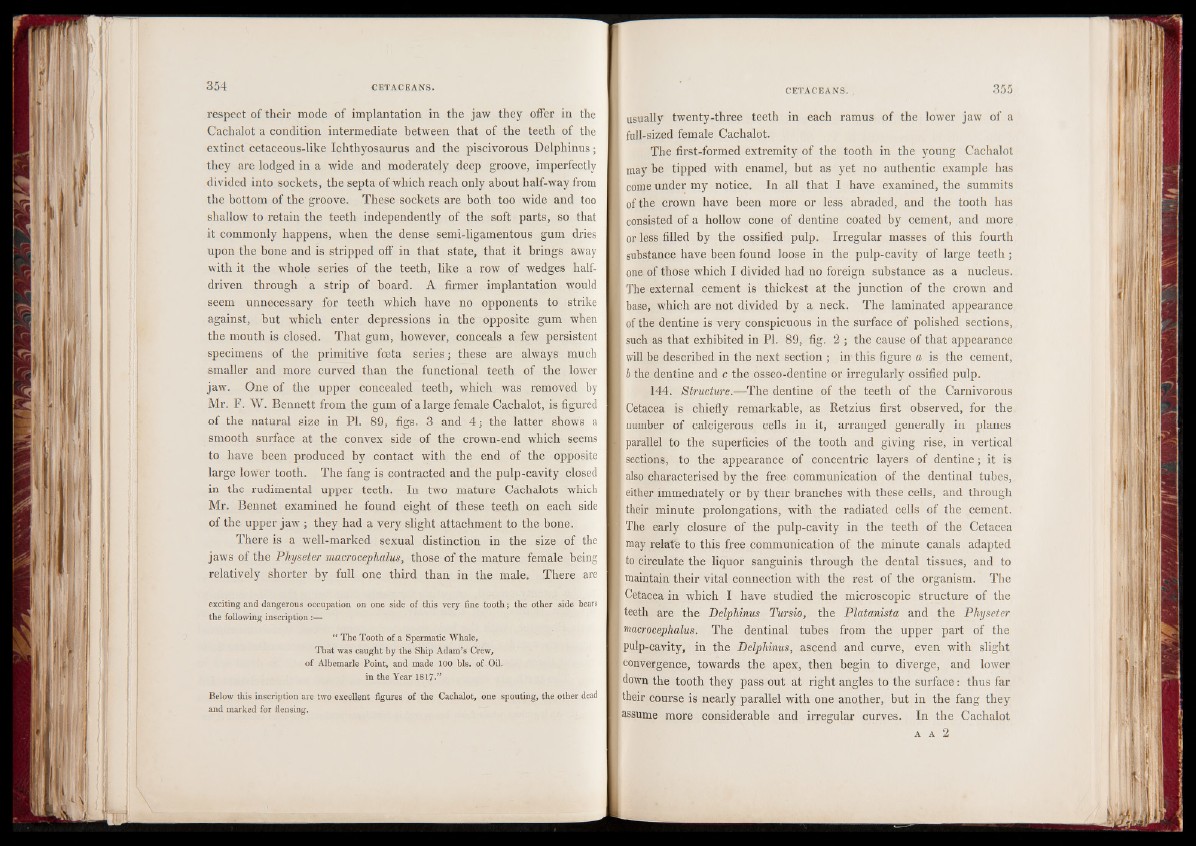
respect of their mode of implantation in the jaw they offer in the
Cachalot a condition intermediate between that of the teeth of the
extinct cetaceous-like Ichthyosaurus and the piscivorous Delphinus;
they are lodged in a wide and moderately deep groove, imperfectly
divided into sockets, the septa of which reach only about half-way from
the bottom of the groove. These sockets are both too wide and too
shallow to retain the teeth independently of the soft parts, so that
it commonly happens, when the dense semi-ligamentous gum dries
upon the bone and is stripped off in that state, that it brings away
with it the whole series of the teeth, like a row of wedges half-
driven through a strip of board. A firmer implantation would
seem unnecessary for teeth which have no opponents to strike
against, hut which enter depressions in the opposite gum when
the mouth is closed. That gum, however, conceals a few persistent
specimens of the primitive foeta series; these are always much
smaller and more curved than the functional teeth of the lower
jaw. One of the upper concealed teeth, which was removed by
Mr. F. W. Bennett from the gum of a large female Cachalot, is figured
of the natural size in PI. 89, figs. 3 and 4; the latter shows a
smooth surface at the convex side of the crown-end which seems
to have been produced by contact with the end of the opposite
large lower tooth. The fang is contracted and the pulp-cavity closed
in the rudimental upper teeth. In two mature Cachalots which
Mr. Bennet examined he found eight of these teeth on each side
of the upper jaw ; they had a very slight attachment to the bone.
There is a well-marked sexual distinction in the size of the
jaws of the Physeter macrocephalus, those of the mature female being
relatively shorter by full one third than in the male. There are
exciting and dangerous occupation on one side of this very fine tooth; the other side bears
the following inscription :—
“ The Tooth of a Spermatic Whale,
That was caught by the Ship Adam’s Crew,
of Albemarle Point, and made 100 bis. of Oil.
in the Year 1817”
Below this inscription are two excellent figures of the Cachalot, one spouting, the other dead
and marked for flensing.
usually twenty-three teeth in each ramus of the lower jaw of a
full-sized female Cachalot.
The first-formed extremity of the tooth in the young Cachalot
may be tipped with enamel, but as yet no authentic example has
come under my notice. In all that I have examined, the summits
of the crown have been more or less abraded, and the tooth has
consisted of a hollow cone of dentine coated by cement, and more
or less filled by the ossified pulp. Irregular masses of this fourth
substance have been found loose in the pulp-cavity of large teeth ;
i one of those which I divided had no foreign substance as a nucleus.
The external cement is thickest at the junction of the crown and
| base, which are not divided by a neck. The laminated appearance
of the dentine is very conspicuous in the surface of polished sections,
I such as that exhibited in PI. 89, fig. 2 ; the cause of that appearance
will be described in the next section ; in'this figure a is the cement,
b the dentine and c the osseo-dentine or irregularly ossified pulp.
144. Structure.—The dentine of the teeth of the Carnivorous
Cetacea is chiefly remarkable, as Retzius first observed, for the
number of calcigerous cells in it, arranged generally in planes
parallel to the superficies of the tooth and giving rise, in vertical
sections, to the appearance of concentric layers of dentine; it is
also characterised by the free communication of the dentinal tubes,
either immediately or by their branches with these cells, and through
! their minute prolongations, with the radiated cells of the cement.
The early closure of the pulp-cavity in the teeth of the Cetacea
may relate to this free communication of the minute canals adapted
to circulate the liquor sanguinis through the dental tissues, and to
maintain their vital connection with the rest of the organism. The
Cetacea in which I have studied the microscopic structure of the
teeth are the Delphinus Tursio, the Platanista and the Physeter
macrocephalus. The dentinal tubes from the upper part of the
pulp-cavity, in the Delphinus, ascend and curve, even with slight
convergence, towards the apex, then begin to diverge, and lower
down the tooth they pass out at right angles to the surface : thus far
their course is nearly parallel with one another, but in the fang they
assume more considerable and irregular curves. In the Cachalot
a a 2